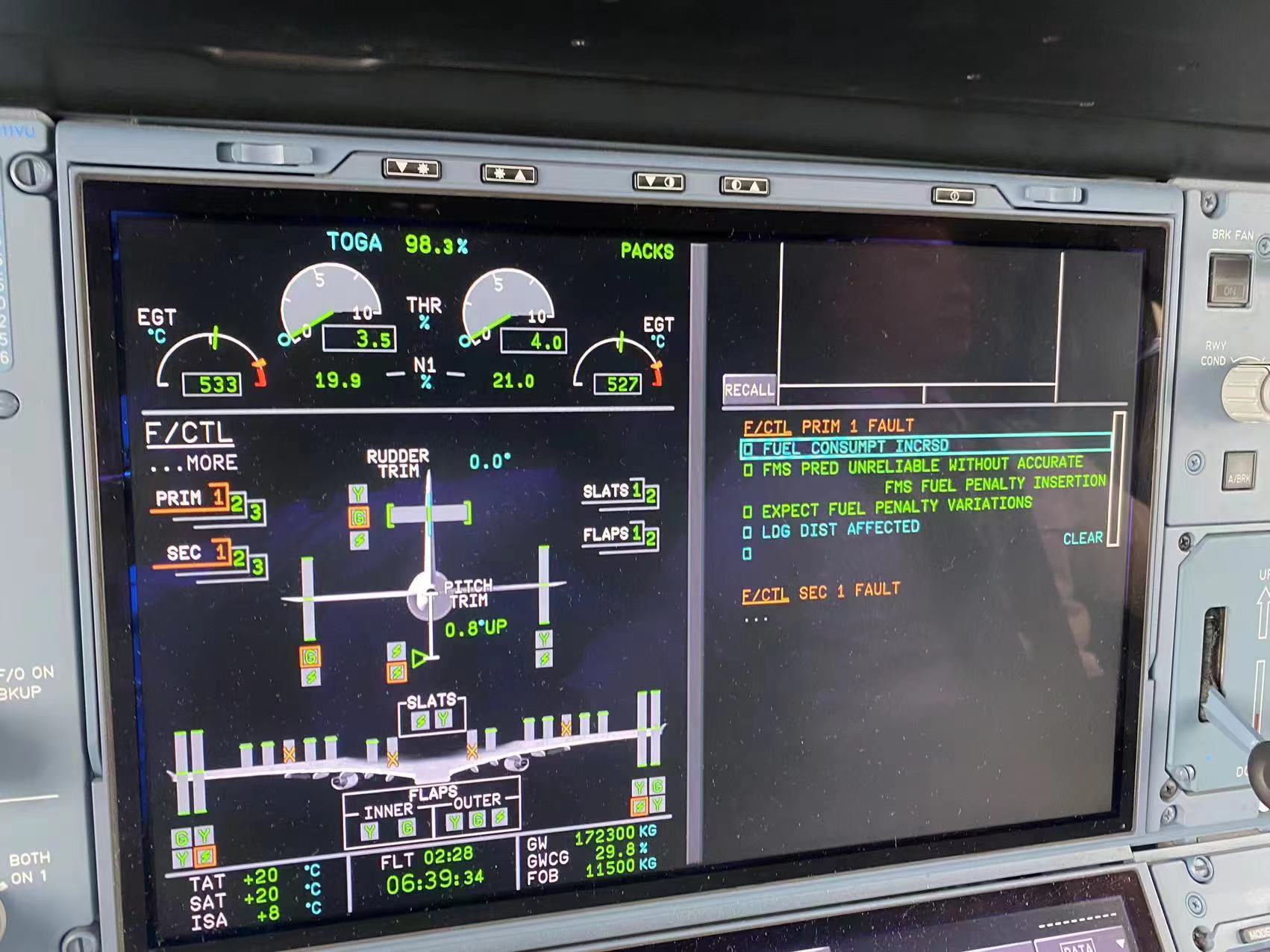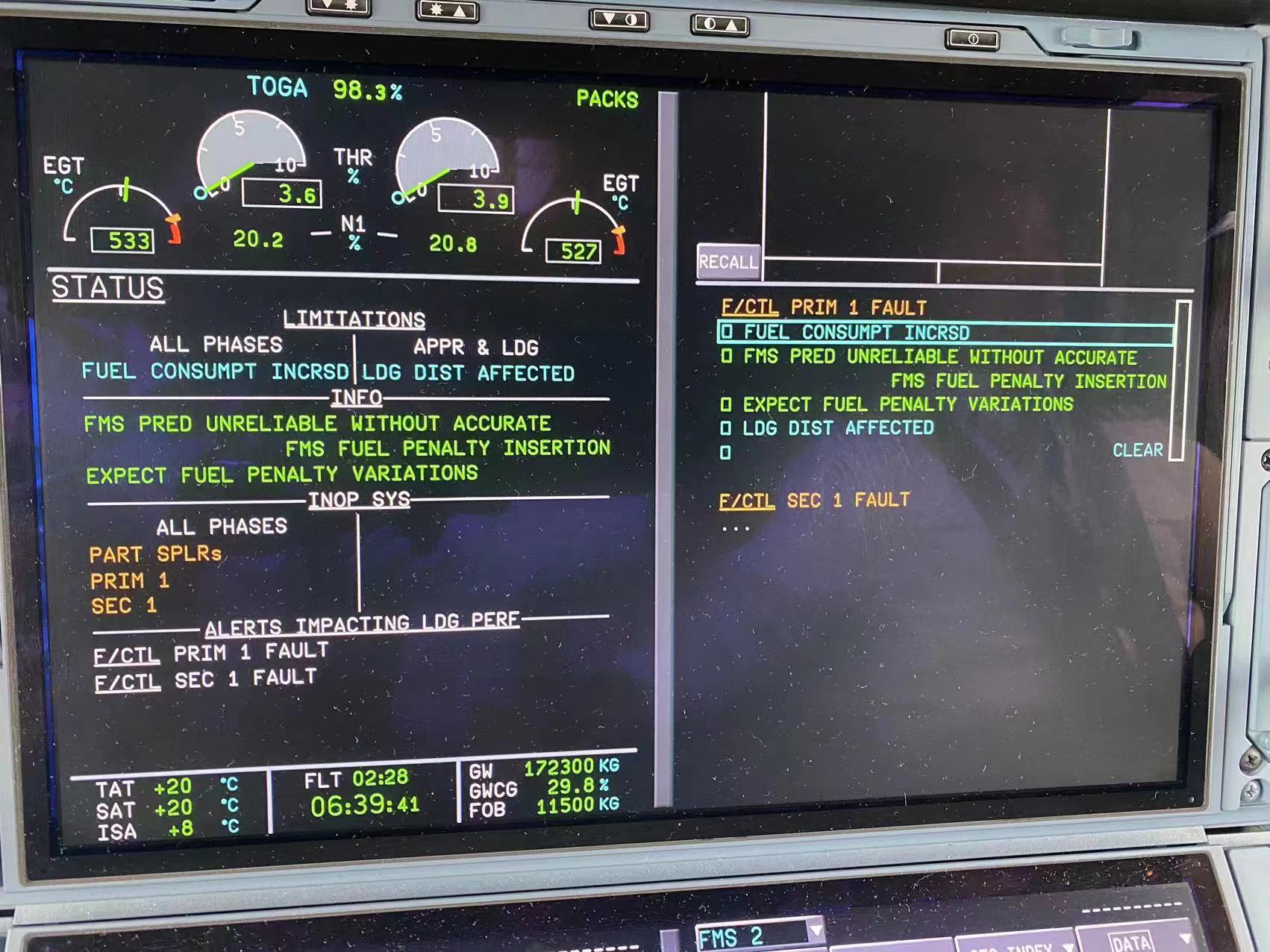(在 AVIONICS BATCH 7 贯彻之后,OEB11 也就不再适用了。本文仅作留档和学习。)
A350 OEB 11 的触发条件是“出现 F/CTL PART(MOST) SPLRS FAULT 警告”。简单来就是因为 ADHF,扰流板会下垂以减小襟翼与主翼面之间的缝隙以优化气流。而如果在构型全的情况下扰流板故障了,收襟翼的时候无法将扰流板推上来。所以在某些扰流板故障的情况下,使用构型全落地的话就收不上襟翼了。详细情况可以参考 FOT 999.0077/22。
但是,在 F/CTL PART(MOST) SPLRS FAULT 警告以外的其他导致扰流板故障情况下,是否需要执行 OEB11?
在不正常程序的“不工作系统”中出现 SPLRs 的,除了 F/CTL PART(MOST) SPLRS FAULT,还有:
- ELEC AC 1A BUS 230V+115V FAULT - AC 1B BUS 230V+115V + DC 1 BUS FAULT
- ELEC AC 1A BUS 230V + AC 2A BUS 230V FAULT - DC 1 + DC 2 BUS FAULT
- ELEC DC 1 BUS FAULT
- ELEC DC 1 + DC 2 BUS FAULT
- ELEC DC EMER 1 BUS ON BAT - DC 1 + DC 2 BUS FAULT (着陆要求构型 3)
- ELEC EMER CONFIG
- ELEC SIDE 1 OFF (SMOKE CONFIG)
- ENG ALL ENGINES FAILURE (根据情况要求构型,一般是 1 或者 2,2 以上则保持)
- HYD G(Y) SYS TEMP LO
- HYD G+Y SYS PRESS LO (在非构型全的情况下要求构型 3)
另外还有一些叠加故障可能会导致扰流板故障,比如
- 特定的一部 PRIM 加一部 SEC 故障
再来看 F/CTL PART(MOST) SPLRS FAULT 的触发条件:
- PART SPLRs: Between one and eight spoilers are failed.
- MOST SPLRs: More than eight spoilers are failed.
如果按照这个条件,上述不正常情况应该都会触发 F/CTL PART(MOST) SPLRS FAULT,然而并不是这样。
空客在回复中证实,只有触发了 F/CTL PART(MOST) SPLRS FAULT,才需要执行 OEB11。其他在 INOP SYS 中包含扰流板的故障情况下,ADHF 让扰流板下垂的量高于收襟翼推不上去的临界值,所以可以放到构型全,也就无需执行 OEB11。
不过这个问题导致的 ECAM 程序在今年贯彻的 AVIONICS BATCH 7 中就彻底更新了,OEB11 也就不再适用了。
原文
Q1:
In the OEB 11, the trigger is F/CTL PART(MOST) SPLRS FAULT ECAM alert. However, some other cases can cause spoilers inoperative, such as:
- ELEC AC 1A BUS 230V+115V FAULT - AC 1B BUS 230V+115V + DC 1 BUS FAULT
- ELEC AC 1A BUS 230V + AC 2A BUS 230V FAULT - DC 1 + DC 2 BUS FAULT
- ELEC DC 1 BUS FAULT
- ELEC DC 1 + DC 2 BUS FAULT
- ELEC DC EMER 1 BUS ON BAT - DC 1 + DC 2 BUS FAULT (着陆要求构型 3)
- ELEC EMER CONFIG
- ELEC SIDE 1 OFF (SMOKE CONFIG)
- ENG ALL ENGINES FAILURE (根据情况要求构型,一般是 1 或者 2,2 以上则保持)
- HYD G(Y) SYS TEMP LO
- HYD G+Y SYS PRESS LO (在非构型全的情况下要求构型 3)
Will the cases above also trigger F/CTL PART(MOST) SPLRS FAULT ECAM alert? If not, should crew apply OEB 11?
A1:
Airbus has not listed all failures leading to triggering the alerts F/CTL PART(MOST) SPLRS FAULT ECAM. However, independently of the failures, we confirm that the OEB 11 is specific to the case where either F/CTL PART SPLRS FAULT or F/CTL MOST SPLRS FAULT alert is triggered.
For CSC information, the procedure of OEB 11 is to use FLAP 3 for landing because, when the alert is triggered and FLAPS FULL is selected, the flap retraction is inhibited. In the case that PART SPLRS or MOST SPLRS is listed only as INOP SYS, there is no flap retraction inhibition. Therefore, there is no need to apply the procedure of OEB 11.
In addition, note that OEB 11 will be canceled with the embodiment of the FWS S7/4.0 as indicated in the FOT 999.0077/22 Rev 02.
Q2:
Thanks for the explanation. That means there're 2 types of spoilers fault, type 1 is which can trigger the F/CTL PART(MOST) SPLRS FAULT ECAM alert, and type 2 is which can not. And only type 1 will inhibit the flap retraction. So actually what is the difference between those 2 types?
However, the trigger condition of F/CTL PART(MOST) SPLRS FAULT is
- PART SPLRs: Between one and eight spoilers are failed.
- MOST SPLRs: More than eight spoilers are failed.
According to the trigger condition, once only 1 spoiler failed, the alert will be triggerd, without any info about types of fault.
A2:
After having carefully reviewed your query, please find below our answer.
With regards to CSC question, there exist two different cases:
Case 1: Failures where PART (MOST) SPLRs are listed as INOP items on the STATUS page.
The display of these items are triggered by other failures and come from other sources. In particular, as shown in image 2 sent by CSC in message /001, the loss of PRIM 1 + SEC 1 (which may be caused by ATA24 Failure for instance).
There is no flap retraction inhibition in flight. In these cases, even if PART (MOST) SPLRs are listed as INOP SYS, the maximum downward commanded droop is always high enough for the flaps to push back the spoilers without structural damage. As a consequence, OEB 11 is not applicable.
Case 2: Failures that lead to F/CTL PART(MOST) SPLRs FAULT alert in flight.
In these cases, having PART (MOST) SPLRs inoperative is the main source of the F/CTL PART(MOST) SPLRs FAULT alert triggering. When the alert is triggered and FLAPS FULL is selected, the flap retraction is inhibited.
We confirm that the recommendation provided in the FOT 999.0077/22 is specific to the case where either the F/CTL PART SPLRs FAULT or F/CTL MOST SPLRs FAULT alert has been triggered.


